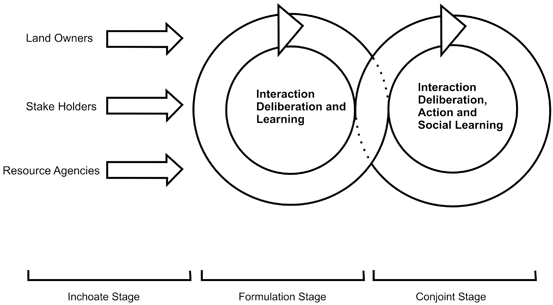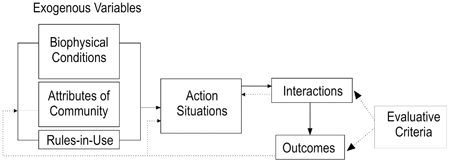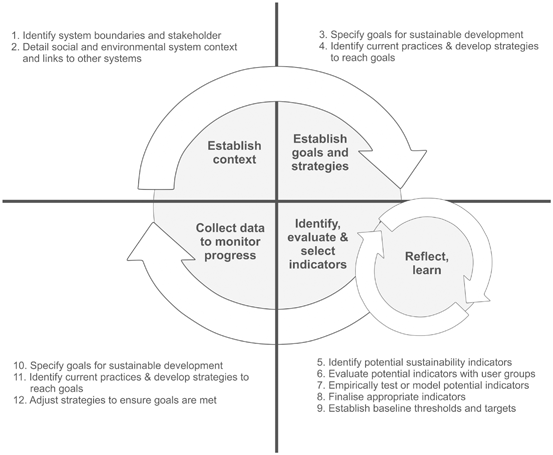Adaptive Co-Management
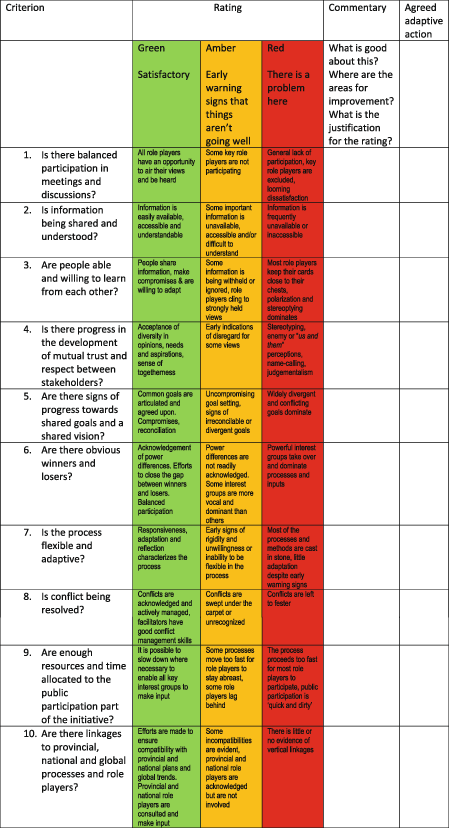
Adaptive management
Co-management
Adaptive co-management
Concept
Learning by doing process
Joint or shared decision making, conflict resolution or management process
Joint management through learning by doing collaboratively
Designed for…
Designed to continually improve management policies and practices by learning from the outcomes of previously employed policies and practices
Designed as an alternative approach from the top down to a consensus based and decentralized approach
Designed to enhance resilience and manage complex systems which transcend multiple levels and scales
Emphasis on…
Learning and experimentation through implementing monitoring and adjusting in real space and time
Sharing of rights, responsibilities and power across a range of relevant stakeholders
Joint management and learning by doing, (local and scientific knowledge), sharing of rights, responsibilities and power by relevant stakeholders at multiple scales
Linkages
Science and management for learning by doing
Vertical institutional linkages for the inclusion of diverse knowledge types and equity in resource sharing and decision making
Horizontal and vertical for joint learning by doing
Temporal scope
Medium to long term, multiple cycles of learning and adapting
Short to medium term, creates snapshots
Medium to long term, multiple cycles of learning and adapting
Organizational level
Managers needs and relationships
Bridging between local and government levels
Multi-level, with self-organized networks
Capacity building focus
Resource managers and decision makers
Community and resource users
All stakeholders
Core Elements
The adaptive co-management process has four cornerstones:
1.
2.
3.
Adaptive co-management thus refers to an ongoing process that allows stakeholders to share responsibility within a system where they can explore their objectives, find common ground, learn from their institutions and practices, and adapt and modify them for subsequent cycles . While, as with adaptive management, the focus remains learning by doing, it takes into account a diversity of knowledge systems. This allows for the inclusion of informal, local and traditional knowledge, formal scientific knowledge and the sharing of rights, responsibilities and power among the diverse range of relevant stakeholders (Ruitenbeek and Cartier 2001). These interactions may occur at multiple levels, e.g., at the local community, provincial, national and even international levels. Stakeholders could include resource users, local stewardship associations, government agencies, and non-governmental organizations (NGOs) (Olsson et al. 2004a). The degree of collaboration can occur on a continuum of involvement which can also vary during different phases of the adaptive management cycle (Ruitenbeek and Cartier 2001).
Adaptive co-management is in essence an approach to ecosystem governance , as a partnership between the state or regulating authority, scientific and media institutions , resource users and “other civil society groups” (Adger 2005). Adaptive governance principles (Clark and Clarke 2011) include (1) the degree of cross-scale interaction between project participants and other governance levels; (2) the “learning and adaptation processes” that have occurred; (3) the extent of shared understandings about the goals and vision for the initiative. The result is integration of human and social “capitals” through cross-scale interactions which provide learning opportunities, with intermediaries and “bridging organizations” playing key roles. This leads to the emergence of a common vision and understanding. Clark and Clarke (2011) used these principles to assess good practices in adaptive governance in five case studies in English national parks. They found a positive correlation between indicators of local sustainability , and the application of adaptive governance principles. They conclude that national park authorities are important bridging organizations that promote sustainability through capacity development and trust building.
Despite being very well defined and its core elements explicit, adaptive co-management is sometimes misused or incorrectly used. In some papers a project or case study called adaptive management often contains a collaborative or community engagement component and should actually be called adaptive co-management . The “co” in the term is also interchangeably used as communal or collaborative, implying varied partnerships between public and private actors (Carlsson and Berkes 2005). The most widely used definition of adaptive co-management is: a process by which institutional arrangements and ecological knowledge are tested and revised in a dynamic, ongoing, self-organized process of learning by doing (Folke et al. 2002, Armitage et al. 2007).
Where is Adaptive Co-management Applicable?
Adaptive co-management is not the answer to all management challenges (Plummer 2009), but has been useful in dealing with complexity (Carlsson and Berkes 2005), when decentralization of management is desirable (Bulkeley and Betsill 2005) or there is a need to legitimize decision making (Carlsson and Berkes 2005), in conflict resolution (Pomeroy and Berkes 1997, Singleton 1998), and problem solving (Carlsson and Berkes 2005).
Dealing with Complexity
Adaptive co-management is useful in dealing with complex multi- scale and level systems and with problems where a need to link a diversity of types and levels of organizations is required through partnerships (Carlsson and Berkes 2005, Armitage et al. 2009). This may be due to conflict, or a high level of interdependence (Ansell and Gash 2007), risk sharing, or exchange of resources (Carlsson and Berkes 2005) e.g., herbicide being provided by a conservation authority to private landowners to clear alien invasive species on private property, or provision of free advice and assistance with infrastructure by conservation bodies to communities involved in integrated conservation and development projects (Garnett et al. 2007). No single agency or local user group governing the system alone will work (Carlsson and Berkes 2005, Berkes 2009); the problem requires ongoing committed cooperation and collaboration by a range of stakeholders, which is where adaptive co-management comes into its own.
Decentralization of Management
Adaptive co-management has also commonly been associated with the decentralization of natural resource management of a commons, landscape or small scale resource (e.g., urban ecosystems, Bulkeley and Betsill 2005) where local level knowledge is required; or when distinct rights to resources are shared. Decentralization should be to an appropriate level, congruent with the scale of the ecosystem being managed (Bohensky and Lynam 2005). In the same way as it does not make sense to devolve the authority to manage a regional catchment to a local community, it also would not be appropriate for central government to take sole responsibility for the management of a locally used stream, wetland or community forest (Murphree 2004).
Legitimization of Decision Making
Government agencies can also use adaptive co-management to legitimize decision making, to delegate functions too costly to manage, or to allocate tasks where divisions of labor across levels and capacities can improve efficiency, for example when a group of local producers gains access to new markets through increasing economies of scale (Carlsson and Berkes 2005).
Conflict Resolution and Problem Solving
Conflict can be a barrier to collaboration but can also be the inspiration for collaboration when stakeholders realize that the issue at hand cannot be solved without working together. Adaptive co-management can be applied as a conflict resolution mechanism between stakeholders and government (Pomeroy and Berkes 1997, Singleton 1998, Armitage et al. 2009) or where a policy deadlock occurs (Ansel and Gash 2007) and even evolve into a problem solving mechanism with time. The process can include negotiation and bargaining where the rights and responsibilities of the relevant stakeholders can become explicit, formalized and entrenched, potentially resolving conflicts over resources (Carlsson and Berkes 2005).
Conceptual Frameworks
Plummer and Baird (2013) offer one abstract model which represents the adaptive co-management process as an evolving process consisting of three stages: “inchoate”, where actors with a shared resource or issue exist but have yet to begin interaction; “formulation” where the actors engage and begin interacting and deliberating; and “conjoined” where the actors continue to interact and deliberate and implement actions, monitoring and adapting or modifying approaches and practices (Fig. 9.1). They acknowledge that evolution is seldom as linear as depicted in the model and that the process is “dynamic and ongoing”.
Research on the design principles for adaptive co-management centers around five core elements (Plummer and Baird 2013, Pratt Miles 2013, Wallis et al. 2013):
1.
Establish an institutional platform for collaboration and stakeholder interaction. Because adaptive co-management typically addresses a series of ‘wicked problems’ (sensu Rittel and Webber 1973, Ludwig 2001), stakeholder opinions should be canvassed early and frequently. Appropriate forums for this type of interaction are essential.
2.
Obtain input from key stakeholders at critical points in the adaptive management process. It is particularly important to embrace rather than avoid diversity of opinions and to adopt a ‘soft systems’ approach (Checkland 2000) which allows objectives to shift and be re-defined as stakeholders become more aware of the complexities, their common interests and their differences (Cundill et al. 2012).
3.
Communicate and share data and information. This can be done during face to face meetings or by using technology, social media and web-based platforms to promote citizen science (Tulloch et al. 2013).
4.
5.
Adapt, adjust and even re-design the decision-making structures and governance systems when new information becomes available (Wallis et al. 2013).
Attributes that promote good governance include “participation, representation, deliberation, accountability, empowerment, social justice, and organizational features such as being multilayered and polycentric”. These attributes need to be coupled with system resilience attributes such as appropriateness of scale, the capacity to adapt to uncertainties, the capacity to maintain diversity, and to combine different sources of knowledge, and, importantly, the ability to detect looming thresholds (Lebel et al. 2006). The feedbacks between governance attributes and resilience attributes ultimately affect the system’s capacity to “self-organize”, “learn” and “adapt”, which are measures of system resilience (Fig. 9.2).
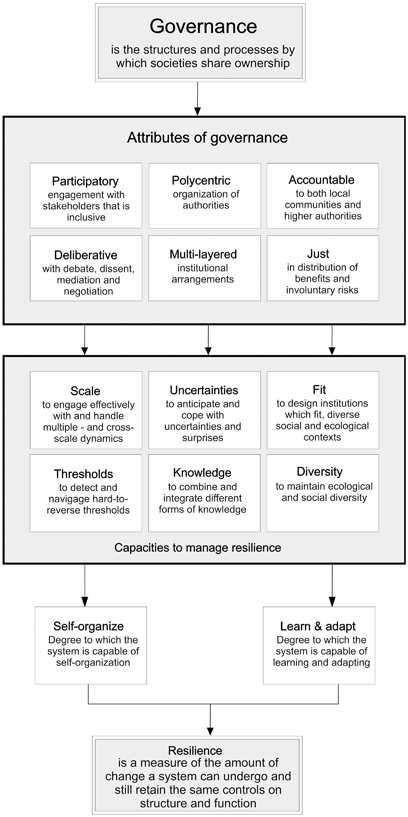

Fig. 9.2
Associations between selected attributes of governance systems and the capacity to manage resilience (reproduced from Lebel et al. 2006)
One of the outcomes of adaptive co-management is that all actors will ultimately, and to varying degrees, perceive the system as integrated, complex and adaptive, with interactions and feedbacks between resource users, resources, ecosystems, governance and public infrastructure (Anderies et al. 2004). Learning, constantly assessing and understanding interactions, not only at the focal scale but also vertically across scales, is central to adaptive co-management. This is graphically depicted in Ostrom’s (2009) social-ecological systems framework which emphasizes that the interactions between system components are less well understood than the components themselves. Ostrom and Cox (2010) emphasize that institutional complexity is the rule rather than the exception in social-ecological systems and warn against “panaceas” consisting of single solutions and diagnostic frameworks. They advocate a multi-tiered approach and suggest the use of multiple frameworks. In their IAD (Institutional Analysis and Development) framework, seven components: the institutional actors; their roles or ‘positions’; the actions that they are allowed; their ‘levels of control’; the outcomes for each actor; the information each actor has at their disposal; and the incentives, costs and benefits associated with their actions, are viewed as important (Fig. 9.3; from Ostrom and Cox 2010).
Fabricius et al. (2007) developed a design framework, based on the community-based assessments of the Millennium Ecosystem Assessment (Folke et al. 2005). The framework (Fig. 9.4) could also be used for diagnostic purposes to differentiate between “powerless spectators”; “coping actors” and “adaptive co-managers”. The framework hinges on two factors: stakeholder’s capacity for governance; and their adaptive capacity . When governance capacity and adaptive capacity are low, stakeholders are mere spectators who powerlessly observe events unfold and affect them. When adaptive capacity is high but governance capacity low, stakeholders merely cope without taking part in management. Only when both adaptive capacity and governance capacity are strong enough can adaptive co-management be effective. Fabricius et al. (2007) conclude that ‘adaptive manager’ communities have both adaptive capacity and governance capacity to sustain and internalize this adaptation. They invest in the long-term management of ecosystem services. Such communities are not only aware of the threats, but also take appropriate action for long-term sustainability . The enablers of adaptive co-management include having adequate endowments of ecosystem services ; leadership; vision; knowledge networks; polycentric institutions; enabling policies; and motivation (including incentives) to take action (Fig. 9.4).


Fig. 9.4
Three types of adaptive communities along gradients of adaptive capacity and governance capacity, respectively. “Powerless spectator” communities have a low adaptive capacity and weak capacity to govern, do not have financial or technological options, and lack natural resources, skills, institutions, and networks. “Coping actor” communities have the capacity to adapt, but are not managing social–ecological systems. They lack the capacity for governance because of lack of leadership, of vision, and of motivation, and their responses are typically short term. “Adaptive manager” communities have both the capacity to adapt and the governance capacity to sustain and internalize this adaptation. They invest in the long-term management of ecosystem services. Such communities are not only aware of the threats, but also take appropriate action for long-term sustainability. Adaptive co-management becomes possible through leadership and vision, the formation of knowledge networks, the existence or development of polycentric institutions, establishing or maintaining links between culture and management, the existence of enabling policies, and high levels of motivation in all role players (adapted from Fabricius et al. 2007)
Contextual factors, despite being extremely important, are often overlooked when attempting to understand adaptive co-management . No two cases are alike and the same case at one point in time might have a different context at a different point in time. Plummer and Hashimoto (2011) describe two fishery case studies, in Canada and Japan, with different contexts and different outcomes. Physical geography, e.g., connectedness of the fishery to fish stocks, culture and traditions of cooperation, and the “embeddedness” of co-management in national and local cultures are important contextual factors to consider. They offer a framework to help understand the relevance of context in adaptive co-management (Fig. 9.5).
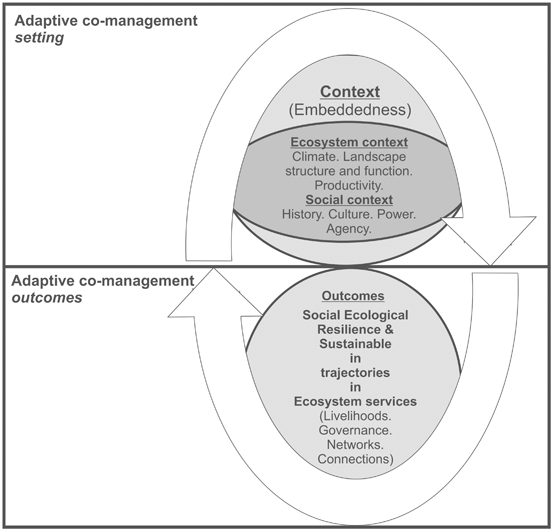

Fig. 9.5
Framework for tailoring adaptive co-management and enhancing adaptability (reproduced from Plummer and Hashimoto 2011)
Contextual factors often provide the backdrop for participation, an intrinsic component of adaptive co-management. Stringer et al. (2006) outline the reasons why participation is important and provide a framework for designing a participatory learning process at different stages in the adaptive co-management cycle (Fig. 9.6).
An Enabling Policy Environment
For adaptive co-management to take place it is essential that a facilitating or enabling institutional policy and legislative environment is created or provided (Olsson et al. 2004a). This either enables or disables real power and responsibility sharing (Armitage et al. 2009). To allow for the necessary experimentation to take place and for dealing with the complex nature of the systems, the policy and legislative environment should be flexible and adaptive (Berkes 2009); transcend multiple spatial levels and time scales horizontally (e.g. across a landscape) and vertically (e.g., across different levels of governance) (Huitema et al. 2009, Armitage et al. 2009); be innovative and offer incentives (Rouse 2008); include the provision of funds, resources and capacity for monitoring (Barthel et al. 2005); facilitate collaboration (Barthel et al. 2005); enable self-organization, i.e., growth of formal and informal networks for information flow that incorporate a diversity of knowledge types and develop formal and informal rules and norms (e.g. constitutions, laws, policies, behaviors and conventions) (Barthel et al. 2005, Berkes 2009, Armitage et al. 2009); play a role in empowering and improving capacity for collaboration by promoting repeated interaction, preferably through face to face dialogue (Armitage et al. 2009).
Social Learning in Adaptive Co-management
Social learning is integral to adaptive co-management (Cundill and Fabricius 2009, Roux et al. 2011). Armitage et al. (2008) assessed the learning theories in adult education, organizational development and business management that inform adaptive co-management. According to Armitage et al. (2008) three types of learning are possible in adaptive co-management:
a.
Experiential learning: learning through experience or doing which occurs in a continuous learning cycle of four phases: (1) concrete experience, (2) reflective observation, (3) abstract conceptualization (4) active experimentation (Kolb 1984).
b.
c.
Social learning: learning with others in a continuous cycle of reflection through shared experiences, ideas and environment. Social learning includes single, double and triple loop learning (Armitage et al 2009).
When the conditions for social learning are present, sustainable outcomes are more likely to be achieved than when the conditions are absent (Clark and Clarke 2011). Aspects that need to be incorporated into the design of social learning experiments include (Bos et al. 2013): (a) a “shared learning agenda” that guides the operational environment and provides meaning; (b) political legitimacy that endorses activities; (c) dedicated financial and other resources to enable implementation of innovative experiments; (d) projects that are locally driven and which draw on a wide range of knowledge systems; (e) multi-organizational learning groups that serve as learning platforms; (f) partnerships between research and management; (g) multiple responsibilities for facilitation, distributed across a variety of actors and organizations; (h) room for adaptation and innovation; and (i) enough time to develop trust. The Cooks River Sustainability Initiative in Sydney (Bos et al. 2013) provides an example of the application of these principles in practice (Box 1).
Box 1. A governance experiment in social learning in the Cooks River Sustainability Initiative, Australia (Bos et al. 2013)
To promote social learning in the Cooks River catchment in Sydney, Bos et al. (2013) initiated a governance experiment aimed at transforming water planning and governance in the catchment. The “OurRiver” Cooks River Sustainability Initiative was designed to develop stakeholder-driven management plans for six sub-catchments in the river system. Stakeholders were encouraged to explore ways to find synergies between their agendas and initiatives, and the researchers’ roles were to promote interaction and communication. Several official and civil society groups operating across the municipality were identified, and these interacted during steering committee meetings, technical working groups and workshop sessions.
Their innovations included using a fine-grained, sub-catchment perspective, working and cooperating across disciplines, working closely with local communities in seeking solutions, and taking a regional approach to governance. This resulted in inter-organizational cooperation and the adoption of a systems perspective, with technical specialists learning to engage with local communities and everyone exploring new technologies.
Examples of the application of adaptive co-management design principles applied in this governance experiment included:
Shared learning agenda—In the Cooks River Sustainability Initiative the project’s ‘shared learning agenda’ was to explore “mutual interdependencies” between officials and citizens to develop “context-specific solutions”.
Legitimacy—They received political endorsement from the respective mayors.
Resources—They received grant funding for proposal development and follow-up funding from municipal budgets.
Focus—Their focus was on sub-catchment planning that drew on a variety of disciplines.
Multi-organizational peer groups—They appointed a variety of steering and expert committees as learning platforms.
Distributed facilitation—The project included numerous facilitators from the project team, university partners and steering committee members.
Science and research—Scientists provided expert advice throughout the initiative, but especially in the early stages.
Adaptability—The facilitators and the process needed to be flexible due to the culturally and geographically diverse sub-catchments involved.
Time—It took time to build trust and to appreciate the complexity of the challenges being addressed.
Collaboration
Collaboration can be conceptualized as: (1) an exchange system between separate spheres where information, goods and or services are exchanged; or (2) a joint organization with overlapping sectors for formal cooperation; (3) governmental/state imbedded systems where the state holds the legal rights and private stakeholders are entrusted with responsibilities; (4) a community nested system where the resource users have the rights; and (5) a network, where the state consists of numerous authorities and agencies (Carlsson and Berkes 2005). The stakeholders or resource users (Ostrom 2009) have a role in committing to and buying into long term open and transparent communication processes, where trust and social capital can be built (Armitage et al. 2009, Olsson et al. 2004a,b). In this context, leadership is essential to create an enabling environment. All stakeholders have the responsibility to ensure inclusivity and the development of a shared understanding and vision (Brink et al. 2010). The development of a shared vision, trust and commitment develops over time, with facilitators and bridging organizations playing a crucial role to ‘soften’ interactions and promote open dialogue (Childs et al. 2013). Over time self-organization, shared responsibility and empowerment will develop. Empowerment is not usually a starting point but rather an outcome of the process of adaptive co-management which will enhance equity, efficiency in decision making and legitimization of actions taken by authorities and institutions (Fabricius et al. 2007).
Actors Involved in Adaptive Co-management
The governance partnership that constitutes adaptive co-management incorporates local resource users, technical experts (including academics), regulating authorities and, in some cases, private business. Donor agencies and their advisors and consultants may also play a supporting role (Fabricius and Collins 2007). Local resource users are the primary stakeholders and their contributions are important. In adaptive co-management all actors should have the right to participate in decision making, share information and contribute to solutions.
1.
Leaders are the legitimate representatives of a constituency playing an important role because it is not always possible for every individual in a group to participate (Olsson et al. 2004a). They have personal power and are crucial to the success of adaptive co-management. The ideal leader should act in the interest of the group and society and should adopt a broader strategic long term approach. But many leaders focus solely on representing the interests of their own constituencies, or promote their own interests which creates new vulnerabilities and conflicts (Ezzine De Blas et al. 2011).
2.
Intermediaries take the form of bridging organizations or ‘boundary organizations’ facilitating communication and knowledge building, and trust and cooperative behavior. Scientists and facilitators are ideally suited for the role, but it does require time commitments beyond the typical three-year project cycle (Clark and Clarke 2011, Roux et al. 2011).
3.
Resource users are the primary stakeholders who depend on the resource base for their well-being, either by directly using the resource, depending on it for regulating or supporting services, or by relying on it for cultural purposes.
4.
Regulators or public infrastructure providers (sensu Anderies et al. 2004) are officials and their organizations tasked with implementing government or other regulations. They benefit from adaptive co-management through a reduction in the transaction costs of resource management, learning from local people, and reduced conflicts (Redpath et al. 2013).
In adaptive co-management , the vertical linkages between actors are vital for the flow of information and knowledge, and to ameliorate or mediate the interactions between actors (Plummer and Baird 2013). Adger et al. (2005) identified five types of linkage functions of adaptive co-management: a forum for participatory management; a provider of vertical linkages for participation; a connector of local resource users to similar users elsewhere; a conduit that connects all actors to scientific information; and an influencer of policies and regulations. These linkages are instrumental in the co-production of knowledge (Berkes 2009), especially if bridging organizations are involved (Clark and Clarke 2011). The relevance of cross-scale linkages is not unique to adaptive co-management and is crucial in all resource management systems (Berkes 2009). It is the failure to acknowledge such interactions that often results in unexpected or undesirable outcomes or conflicts (Adger et al. 2005).
Processes of knowledge gathering, knowledge sharing, interpretation of complex information, and application of knowledge requires trust and mutual respect (Dale and Armitage 2011). When there is investment in the “intermediate steps” of trust building and communication, actors become more reasonable and accommodating of each other’s views during the early stages if there are skilled intermediaries (Monroe et al. 2013). The awareness of actors of the issues forms the foundation for a common vision, motivation, including financial and non-financial incentives to co-create solutions, and capacity to act (Plummer et al. 2013). This often leads to motivation and capacity which enable role players to constructively interact to determine future actions (Lambin 2005) (Table 9.2).
Table 9.2
Stakeholders, their roles and benefits derived from adaptive co-management
